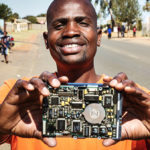This blog was originally published on the Huffington Post
As I watch the unfolding story of cyber outlaw Edward Snowden skipping around the globe, I’m struck by the talented young man who employers “fought over,” despite the fact that he had no formal STEM education. In contrast, the National STEM Conference in Austin last week brought together over 1,500 folks to ponder and discuss the critical need for more American students to be knowledgeable in science, technology, engineering and math, or STEM.
While many young people today are brought up with some innate sense of these skills, as Snowden was, this conference dared us to imagine the innovation and creativity that could come from this future generation if they were provided the formal education to reach their full potential in these fields.
All the participants at the National STEM Conference brought diverse ideas to the table. Corporate leaders mixed with curriculum developers who chatted with government officials who socialized with teachers. More than one session and hallway chat highlighted the desperate need to interest and retain younger and younger students in STEM education. Fewer conversations occurred about the relevancy of field. Even fewer attendees spoke about their own education “journeys,” when a STEM learning moment drove them into their current career path.
In the 72 hours of the conference, I heard the need for a “Sputnik moment” come up at least 15 times in conversation and presentations. Granted, many of the attendees were old enough to remember that moment when our president called for action and our local governments responded (not, by the way, with a media blitz).
No one posted it on Facebook or wrote about it on Tumblr. Instead, individuals, extended families, even the postman, gathered around kitchen tables, in living rooms and backyards, to have conversations about building rockets, going to the moon, and pushing the boundaries of America’s frontier, because space exploration was going to be possible. Much advancement in science and technology came about because our children were listening to those very same conversations that adults were having. While some of those children had role models working in STEM fields, a larger proportion of them had average worker bee parents with stay-at-home moms who were just excited about the future. It was the act of being exposed to conversations about the prospects for the future that propelled many a student to grow to love science and math. And to use that knowledge as the foundation to invent, create, and explore.
Also at the National STEM Conference, 100 CEOs were honored for their STEM leadership; no doubt each company is doing its best to promote innovation and the advancements of various STEM studies. But as I looked at the CEOs in attendance, all old enough to remember Sputnik, I wondered how many of them are actively engaged in social media today. I suspect many do not have a virtual presence and do not seek out opportunities to engage in online discourse about what tomorrow may bring. But in today’s world, how will our children overhear the conversations about the potential of tomorrow? How will they know that we adults are expecting greatness from them?
Unlike the 1950s, we now live in an age where we can easily communicate across borders and generations through social media, video blogs, community sites, and more. With these developing technologies we now have many ways to inspire our youngest generation to think beyond the status quo and become the innovators of the future. Through social media, CEOs at the STEM conference could have been talking to a room full of excited students rather than other professionals already in their field — thus creating a moment in time that could ignite a generation.
It is up to us, as adults and leaders, to create excitement in our conversations about the future. Society’s greatest challenges will be solved in our lifetimes by the next scientists, technologists, engineers, and mathematicians. Many of them will become great artists, using both sides of their brains to find creative solutions to world problems.
Our “Sputnik moment” is here. It is the fact that we are all connected, virtually if not physically, and this has changed our lives more dramatically than placing a man on the moon. We live in a globally connected and transparent world where we can learn from one another. We can’t forget that our children are listening and watching on the streets and online. They want to see if we are excited about their prospects. Let’s have more conversations with enthusiasm and demonstrate to them our belief that more children today have the ability to learn science, technology, engineering, and math than ever before. Let’s tell them they have the power to make tomorrow better than it is today.
The Cisco CSR team was among more than 2000 business, education, and government leaders from around the United States to attend the National STEM Conference June 17 to 19, in efforts to continue change in STEM (science, technology, engineering, or math) education, policy, and workforce development.


Dear Ms. Petrillo,
I thoroughly enjoyed your article, not only as a current teacher, who sees the challenges and opportunities that we have as a society, but also as a former researcher in Social Responsible Investment.
Reading your article triggered in me the old desire to further collaborate in the area of Social Responsible Investment. I wonder if you could guide me in finding new opportunities in this area.
Sincerely,
Antonio Montilla